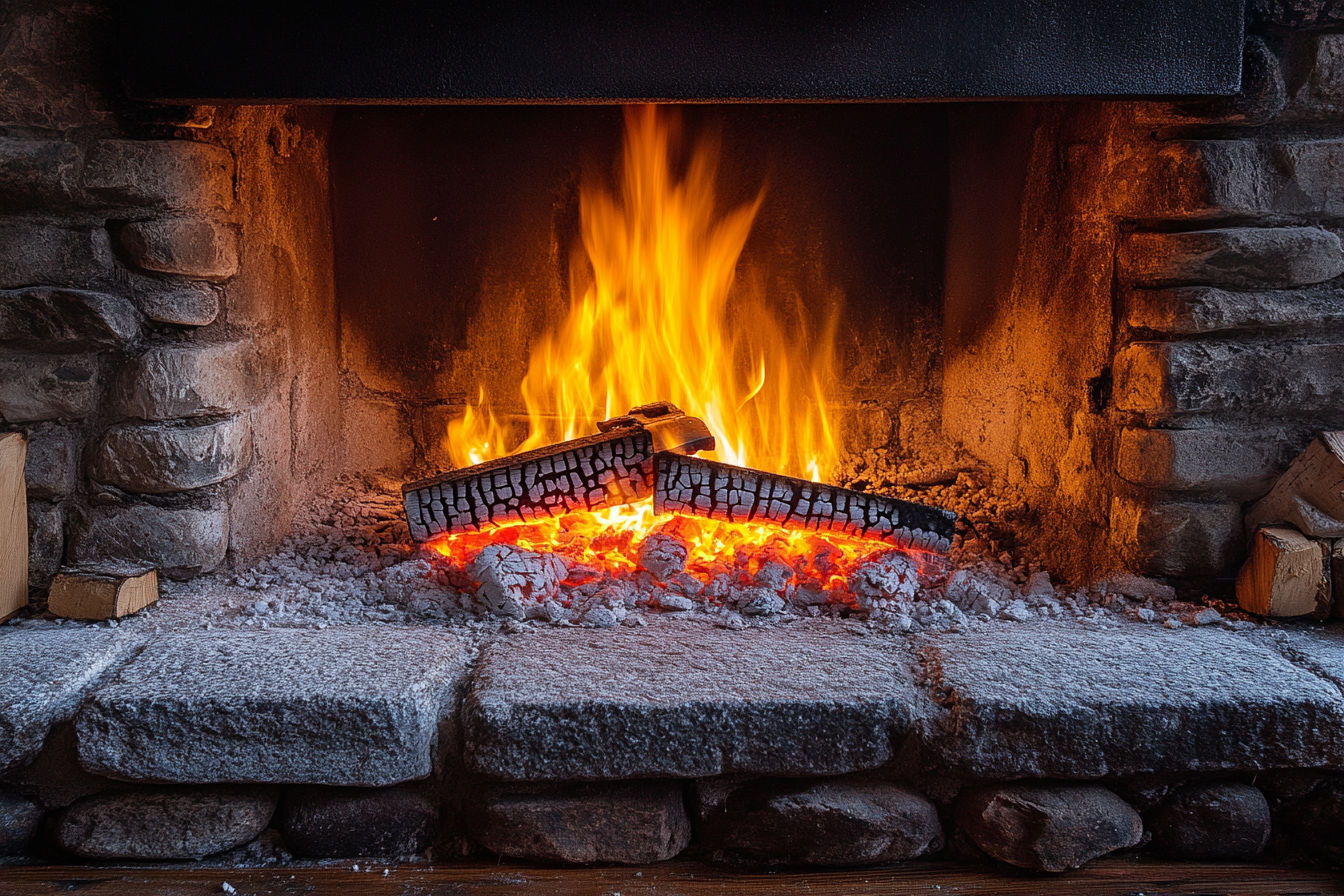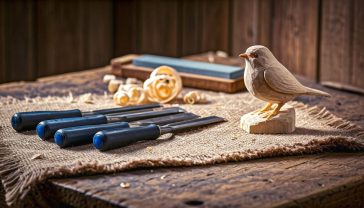A Proper British Guide to Fireplace Bellows: Your Ultimate Companion for a Roaring Hearth
Your definitive guide to fireplace bellows. Discover their history, how to use them safely, and tips on care, plus a step-by-step DIY project for your home.

This post may contain affiliate links. If you make a purchase through these links, we may earn a commission at no additional cost to you.
There’s nothing quite so comforting as a crackling fire on a damp, grey British evening. It’s a scene straight out of a classic novel: the gentle pop of logs, the warm glow pushing back the shadows, and a good cuppa in hand. But getting that perfect, roaring fire isn’t always as simple as striking a match. Sometimes, a dwindling flame needs a bit of encouragement. And for centuries, the go-to tool for that job has been the humble, yet brilliant, fireplace bellows.
Forget prodding at embers with a poker or, heaven forbid, blowing on them and getting a face full of ash. Bellows are the elegant, efficient way to breathe life back into your fire. They deliver a targeted jet of air precisely where it’s needed, turning a sulking pile of coals into a dancing blaze.
This guide is your complete companion to the world of fireplace bellows. We’ll explore their fascinating history, right here in the UK. We’ll break down exactly how they work their magic, look at the different types you can buy, and give you practical tips on using and looking after them. And for those who fancy a weekend project, we’ve even got a straightforward guide to making your very own. So, pull up a comfy chair, get settled, and let’s dive into the art of mastering your hearth.
What Exactly Are Fireplace Bellows and How Do They Work?
At its heart, a bellows is a very simple air pump. Think of it as a pair of lungs for your fireplace. It’s designed to take in a big gulp of air from the room and then puff it out in a strong, focused stream.
The Simple Science Behind the Puff
Every fire, from a tiny candle to a massive bonfire, needs three things to burn: fuel (like wood or coal), heat (from a match or lighter), and oxygen. When a fire starts to die down, it’s often because it’s running low on oxygen. The embers are still hot and there’s plenty of fuel left, but the flames have faded.
This is where bellows come in.
- The Intake: When you pull the two handles of the bellows apart, you expand a flexible, sealed chamber in the middle. This creates a vacuum, and air from the room is sucked in through a one-way valve—usually a small, leather-flapped hole on one of the wooden paddles.
- The Squeeze: When you push the handles together, you squeeze this chamber. The one-way valve closes, trapping the air inside. With nowhere else to go, the air is forced out through a narrow metal nozzle at the front.
- The Result: This creates a powerful jet of oxygen-rich air aimed directly at the base of your fire. This sudden rush of oxygen gives the hot embers the boost they need to reignite, quickly bringing your fire back to life.
It’s far more effective than just blowing on the fire. Our breath contains carbon dioxide and moisture, which can actually dampen the flames. Bellows deliver pure, dry air, making them the perfect tool for the job.
The Main Parts of a Bellows
While they can look quite fancy, most fireplace bellows are made of just a few key parts:
- Paddles: These are the two rigid outer boards, traditionally made of wood, that form the body. You hold them by the handles carved at one end.
- The Gusset (or Chamber): This is the flexible, accordion-like material that connects the paddles. It’s usually made of leather or a tough, heat-resistant fabric. It expands to draw air in and compresses to push it out.
- The Nozzle: A metal tube (often brass or steel) at the front that directs the airflow into a concentrated stream.
- The Hinge: A pivot point, usually made of leather or metal, that joins the two paddles at the nozzle end.
- The Intake Valve: The small, one-way flap that lets air in but not out.
- Studs or Tacks: These are the decorative metal pins that hold the leather gusset securely to the wooden paddles.
Together, these simple parts create a tool that is both incredibly functional and often beautifully crafted—a perfect blend of science and art for the fireside.
A Brief History of Bellows: From Ancient Forges to the British Fireside
The idea of fanning a fire is as old as fire itself. Early humans probably used large leaves or animal skins to coax flames. But the invention of the bellows was a game-changer, not just for keeping homes warm, but for shaping the course of human history.
Ancient Origins and the Age of Metal
The earliest evidence of bellows-like tools dates back thousands of years. Ancient civilisations in Egypt and Mesopotamia needed a way to make their fires incredibly hot—hot enough to melt metal. Simple pot bellows or bag bellows, made from animal hides and clay pipes, allowed them to reach the high temperatures needed to forge bronze and iron. Without bellows, the Bronze Age and Iron Age might never have happened.
These early tools were crucial for blacksmiths, who used large, powerful bellows to heat metal until it was soft enough to be hammered into tools, weapons, and armour. In Britain, the Romans brought with them advanced forging techniques, and the blacksmith’s bellows became a vital part of every settlement.
The Rise of the Domestic Hearth
For centuries, fires in British homes were simple, open hearths in the centre of the room. But as castles and manor houses developed, fireplaces with chimneys became more common. This changed how people managed their fires. A contained fireplace needed a more controlled way to manage airflow.
The familiar two-handled bellows we know today became a common sight from the medieval period onwards. They were perfect for the job: small enough to be used by hand, yet powerful enough to get a log fire going.
- Tudor and Stuart Britain: During this era, grand fireplaces were a symbol of wealth. Bellows became more decorative. Craftsmen used fine woods like oak and yew, and decorated them with intricate carvings, family crests, or patterns. They were as much a status symbol as a practical tool.
- The Victorian Era: The Industrial Revolution brought mass production. While many bellows were still handmade, simpler, more affordable versions became available for ordinary homes. With coal becoming the main fuel, a good bellows was essential for getting a stubborn coal fire to catch. Victorians loved their decorative arts, and you can find many beautiful bellows from this period, often featuring detailed brass work and rich, dark woods.
Bellows in British Culture
Bellows weren’t just tools; they became part of the language and stories. A person who is “full of hot air” might be compared to a bellows. In folklore, the blacksmith, with his mysterious forge and powerful bellows, was often seen as a magical figure.
Today, even with central heating, the traditional fireplace holds a special place in the British heart. And the bellows remains the quintessential accessory—a timeless link to centuries of cosy evenings spent by the fire. It’s a piece of living history that still works as brilliantly as it did hundreds of years ago.
Types of Fireplace Bellows: Finding the Right Style for Your Home
When it comes to choosing a bellows, you’re not just picking a tool; you’re choosing a piece of fireside furniture. They come in a surprising variety of styles, materials, and sizes. The right one for you will depend on your fireplace, your home’s decor, and your personal taste.
By Material
The materials used have the biggest impact on a bellows’ look and feel.
- Classic Wood and Leather: This is the traditional and most popular style.
- Wood: Oak is a classic choice, known for its strength and beautiful grain. Pine is lighter and more affordable, often used for rustic or country-style bellows. You can also find them made from richer woods like walnut or cherry. The wood can be left natural, stained dark, or even painted.
- Leather: The gusset is typically made from real leather, which is durable and flexible. It’s often a rich brown or black, held in place with decorative brass or pewter studs.
- Metal Bellows: Less common for homes, metal bellows (often made of cast iron or steel) are more of an industrial style. They are incredibly durable but can be heavy. They hark back to the design of old forge bellows and can look fantastic in a very modern or industrial-themed living space.
- Modern Materials: Some contemporary designs might use synthetic materials for the gusset, like heavy-duty vinyl or canvas. These can be very hard-wearing and offer a different aesthetic, but they may lack the timeless charm of real leather.
By Style and Design
- Traditional English Style: These are often large, with dark-stained wood (like oak or mahogany), a black or deep brown leather gusset, and polished brass tacks and a matching brass nozzle. They might feature carvings, perhaps of a pastoral scene or a coat of arms. They look perfectly at home next to a grand Victorian fireplace.
- Rustic or Farmhouse Style: Think simpler designs, lighter-coloured woods like pine or ash, and perhaps a slightly rougher, more handcrafted finish. The leather might be a lighter tan, and the overall feel is charming and unpretentious. Perfect for a country cottage with a stone fireplace.
- Modern and Minimalist: For contemporary homes, you can find bellows with sleek, clean lines. The wood might be a pale, unstained maple or a dramatic ebonised black. The design will be simple, with minimal decoration, focusing on function and form.
- Antique and Vintage: Hunting for a bellows in an antique shop can be great fun. You might find a genuine Victorian piece with beautiful, age-worn patina on the wood and brass. These aren’t just tools; they are conversation starters, full of history and character. Just be sure to check the leather isn’t cracked or torn.
Size Matters
Don’t forget to consider the size of your bellows in relation to your fireplace.
- Small Bellows (under 15 inches): These are great for small fireplaces, wood-burning stoves, or even outdoor fire pits. They are light and easy to handle but produce a smaller puff of air.
- Medium Bellows (15-20 inches): This is the most common and versatile size. It’s a good all-rounder, powerful enough for most open fireplaces without being too bulky.
- Large Bellows (over 20 inches): If you have a very large, open fireplace (like an inglenook), a larger bellows will be more effective. It can move a lot more air, making it easier to get a big fire going. They also make a grand decorative statement.
When choosing, think about where you will store it. Most bellows come with a leather loop for hanging, which is the best way to keep them safe and on display.
How to Use Fireplace Bellows Properly and Safely
Using bellows is simple, but a little bit of technique goes a long way. Using them correctly will make your fire-lighting efforts more efficient and, crucially, safer.
The Golden Rule: Aim for the Embers, Not the Flames
The biggest mistake people make is pointing the bellows at the flames. This will just blow the flames around and might even blow them out. It can also scatter sparks and ash all over your hearth and carpet.
Instead, your target is the base of the fire, where the embers are glowing. This is where the fuel is hottest and where the oxygen is most needed.
Step-by-Step Guide to Reviving Your Fire
- Get a Good Grip: Hold the bellows by the two handles. It’s a two-handed job.
- Take a Breath: Hold the bellows upright and pull the handles apart smoothly. You might hear a faint whoosh as the chamber fills with air.
- Positioning is Key: Stand or kneel a safe distance from the fireplace. You don’t need to be right on top of it. Extend your arms and aim the nozzle towards the glowing embers at the bottom of the fire grate.
- The Gentle Puff: Gently and smoothly push the handles together. Don’t do it too aggressively at first. You want to deliver a firm but controlled jet of air. Give it one or two puffs.
- Watch and Wait: You should see the embers start to glow more brightly, turning from a dull red to a fiery orange. You might see small flames begin to lick up from the coals or wood.
- Repeat if Needed: If the fire doesn’t catch right away, wait a few seconds and give it another couple of puffs. Be patient. It can take a moment for the new flames to take hold.
- Store it Safely: Once the fire is roaring, hang your bellows back on its hook, well away from the heat and any stray sparks. Never leave it sitting on the hearth.
Safety First: Important Things to Remember
- Keep Your Distance: Always maintain a safe distance from the fire. The long nozzle is designed so you don’t have to get too close.
- Check Your Surroundings: Make sure there are no flammable materials nearby, like newspapers, rugs, or cushions. A stray spark can be dangerous. Always use a fireguard, especially after using the bellows.
- Mind the Ash: A sudden, powerful blast of air can send a cloud of fine ash billowing into the room. Start with gentle puffs to avoid making a mess.
- Wear Gloves: It’s always a good idea to wear heat-resistant gloves when tending a fire, just in case.
- Never Leave a Bellows Near Heat: The wood can scorch, and the leather can dry out, crack, or even burn. Always store it properly after use.
By following these simple steps, you’ll find your bellows to be an indispensable—and safe—tool for keeping your home warm and cosy all winter long.
Caring for Your Bellows: Maintenance and Simple Repairs
A well-made bellows can last for generations, but it does need a little bit of care to keep it in top condition. Wood and leather are natural materials that can be affected by the heat and dryness of a fireside environment. A few simple maintenance steps will keep your bellows looking great and working perfectly.
Regular Cleaning and Care
- Wipe Down the Wood: Every now and then, give the wooden paddles a wipe with a soft, dry cloth to remove any dust or ash. If the wood looks a bit dull, you can revive it with a small amount of wood polish or furniture wax. Apply it with a soft cloth, let it sit for a few minutes, then buff it to a nice sheen.
- Condition the Leather: The leather gusset is the part most likely to suffer from being near a fire. The heat can cause it to dry out and become brittle over time. To prevent this, treat the leather once or twice a year with a good quality leather conditioner (the kind you’d use for shoes or a sofa). This will keep it soft and supple.
- Polish the Nozzle: If your bellows has a brass nozzle, it can tarnish over time. A quick polish with a bit of brass cleaner will bring back its shine and make it look as good as new.
Common Problems and How to Fix Them
Even with good care, you might run into a couple of common issues, especially with older bellows. Luckily, most are easy to fix.
Problem: It’s Not Puffing Properly (A Leak!)
If you squeeze the handles and not much air comes out the front, you’ve probably got an air leak.
- Find the Leak: The most likely culprit is a small hole or tear in the leather gusset. Carefully inspect the leather, especially in the folds and along the edges where it meets the wood. You can sometimes find a leak by closing the bellows, holding the nozzle shut with your thumb, and gently trying to pull the handles apart. You might hear or feel where air is getting in.
- Patching the Leather: For a small hole, you can buy a simple leather repair kit (available from craft shops or online). Cut a small patch of leather slightly larger than the hole. Apply a strong, flexible glue (a specific leather adhesive is best) to the patch and press it firmly over the hole on the inside of the gusset if you can, or the outside if not. Let it dry completely before using.
- Check the Tacks: Sometimes a tack can come loose, creating a gap. If you find one, you can often just gently hammer it back into place.
Problem: The Intake Valve is Stuck
The small leather flap of the intake valve can sometimes get stuck shut with dust.
- Locate the Valve: It’s the small hole on one of the wooden paddles, usually covered by a little leather flap on the inside.
- Clean it Out: Use a small, soft brush (like an old toothbrush) or a puff of compressed air to gently clean around the valve and dislodge any dust or debris.
When to Call a Professional
If the leather is completely torn or has become hard and cracked all over, it might need to be completely replaced. This is a more complex job. If your bellows is a valuable antique or a family heirloom, it’s worth taking it to a professional leather worker or an antique restorer. They can replace the gusset while preserving the original wooden parts, giving it a new lease of life.
DIY Fireplace Bellows: A Weekend Project
Fancy a go at making your own bellows? It’s a satisfying project that combines woodworking and leathercraft. This guide will walk you through making a simple, functional bellows. You don’t need to be a master craftsman, just patient and careful.
What You’ll Need
Materials:
- Wood: Two pieces of pine or oak board, about 1 inch thick. Each piece should be roughly 18 inches long and 8 inches wide.
- Leather: One piece of soft but durable leather (at least 2mm thick), about 12 inches by 24 inches. You can often buy leather offcuts online.
- Nozzle: A short piece of copper or brass pipe, about 3/4 inch in diameter and 3-4 inches long.
- Upholstery Tacks: A box of decorative brass or steel tacks.
- Wood Glue: A strong wood adhesive.
- Leather for Hinge & Valve: A small scrap of thicker leather.
- Wood Finish: Stain, oil, or wax.
Tools:
- Jigsaw or band saw
- Drill
- Sandpaper (medium and fine grit)
- Craft knife or sharp scissors
- Hammer
- Clamps
- Pencil and paper
Step-by-Step Instructions
Step 1: Design and Cut the Paddles
- Draw Your Shape: On a piece of paper, draw the classic teardrop shape for your bellows paddles. A good size is about 18 inches long from the tip of the handle to the wide end, and 8 inches across at the widest point.
- Create a Template: Cut out your paper shape to make a template.
- Trace onto Wood: Trace the template onto your two pieces of wood.
- Cut Them Out: Carefully cut out the two paddle shapes using a jigsaw. Take your time to get a smooth curve. Don’t worry if they’re not identical; you can sand them to match.
- Drill the Holes:
- Nozzle Hole: Clamp the two paddles together perfectly aligned. At the narrow end, drill a hole through both pieces of wood the same diameter as your nozzle pipe.
- Air Intake Hole: On one paddle only, drill a 1-inch hole about a third of the way up from the wide end. This will be the bottom paddle.
Step 2: Shape and Finish the Wood
- Sand Everything: Sand the cut edges and flat surfaces of both paddles until they are smooth. Start with medium-grit sandpaper and finish with fine-grit.
- Shape the Handles: Round off the edges of the handle sections to make them comfortable to hold.
- Apply a Finish: Apply your chosen wood stain, oil, or wax. This protects the wood and brings out the grain. Let it dry completely.
Step 3: Make the Valve and Hinge
- The Valve: Cut a small rectangle of leather (about 2 x 1.5 inches). On the inside of the bottom paddle (the one with the intake hole), use a couple of tacks to fix one end of the leather flap over the hole. It should be able to flap freely, covering the hole. This is your one-way valve.
- The Hinge: Cut a strip of thick leather about 2 inches wide and long enough to wrap around the narrow end of the paddles, just behind the nozzle hole.
Step 4: Attach the Nozzle and Hinge
- Fit the Nozzle: Apply a little wood glue inside the nozzle holes you drilled and push your metal pipe through, so it sticks out the front. It should fit snugly. Let the glue dry.
- Attach the Hinge: Apply glue to the leather hinge strip. Wrap it tightly around the wood and secure it with a few tacks. This creates a flexible pivot for the bellows.
Step 5: Cut and Attach the Leather Gusset
This is the trickiest part, so take your time.
- Measure and Cut: The gusset is a long strip of leather that will be folded and tacked to the edges of the paddles. It needs to be long enough to go all the way around the curved edge of the bellows, from one side of the handle to the other. A flexible tape measure is useful here. The width should be about 4-5 inches.
- Mark a Centre Line: Draw a line down the middle of your leather strip. This will help you keep the folds even.
- Start Tacking: Open the bellows slightly. Start at the hinge end on one side. Use a tack to fix the edge of the leather to the edge of one wooden paddle. Continue placing tacks every inch or so, gently stretching the leather as you go around the curve.
- Repeat on the Other Side: Now, do the same on the other paddle. As you tack the leather, you will create the accordion-like folds. Try to keep them neat and evenly spaced.
- Trim the Excess: Once you reach the handles on both sides, trim any excess leather with a sharp craft knife.
Step 6: The Finishing Touches
- Add a Hanging Loop: Cut a thin strip of leather, fold it into a loop, and tack it securely to the end of one of the handles.
- Final Check: Test your bellows. Pull the handles apart and push them together. You should get a satisfying puff of air from the nozzle.
Congratulations! You’ve just made your very own, fully functional fireplace bellows. It might not be perfect, but it was made by you, and it will make your next fire feel even more special.
Further Reading & Resources
For those looking to delve deeper into traditional crafts or find high-quality fireplace accessories, here are some highly respected UK-based resources:
- The National Trust: Often their historic properties feature incredible original fireplaces and fireside tools. Their online shop sometimes sells traditionally crafted items. https://www.nationaltrust.org.uk/
- English Heritage: Similar to the National Trust, a fantastic resource for understanding the history of the British home. Their shops are great for finding unique, quality gifts. https://www.english-heritage.org.uk/
- The Blacksmith’s Guild (Worshipful Company of Blacksmiths): For those interested in the craft of metalwork, including forged fireplace tools. A great place to appreciate the skill involved. https://blacksmithscompany.co.uk/
- Anevay Stoves: A UK company that specialises in wood-burning stoves and outdoor cooking. Their blog often has excellent tips on fire management. https://www.anevaystoves.com/






